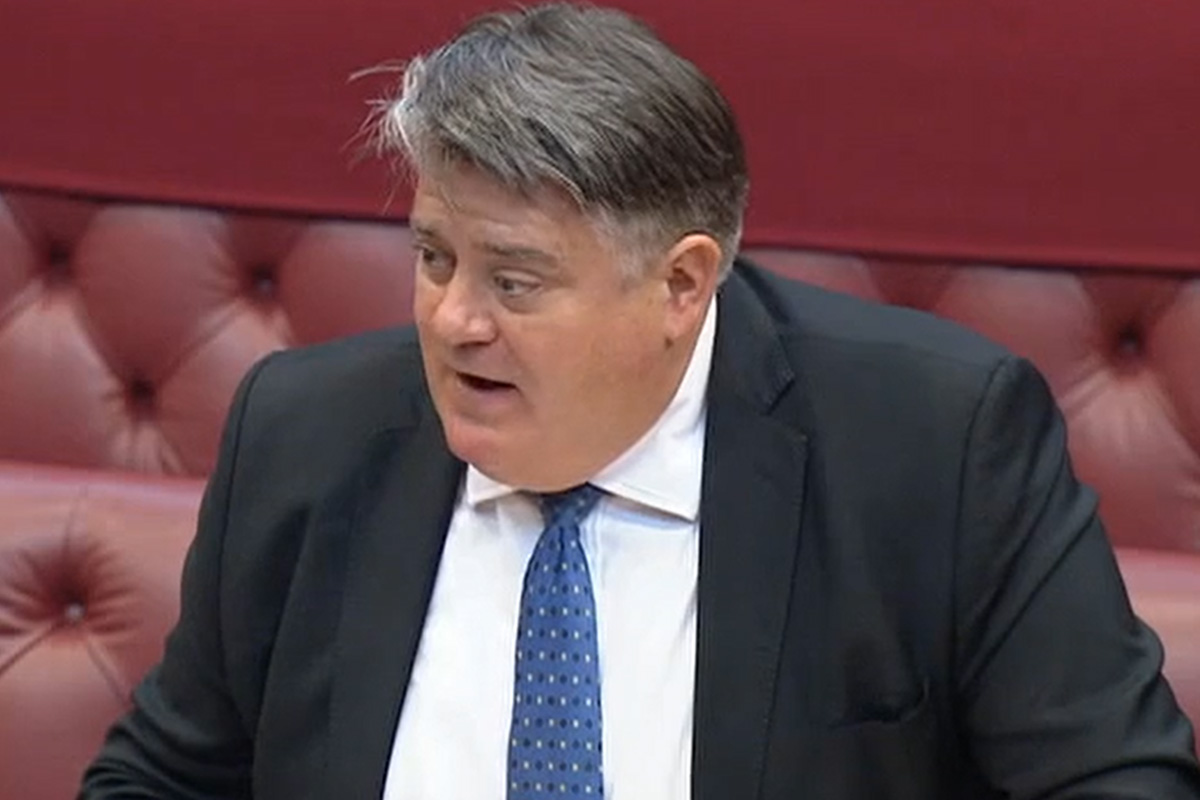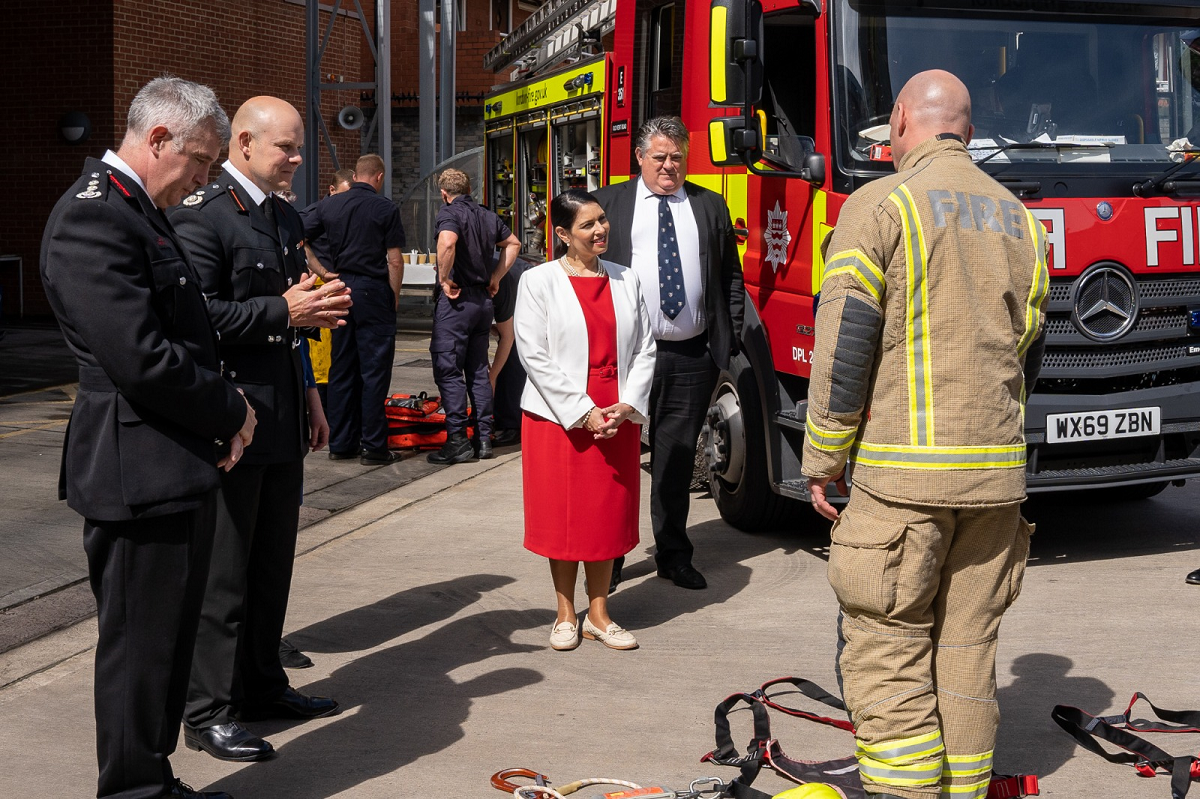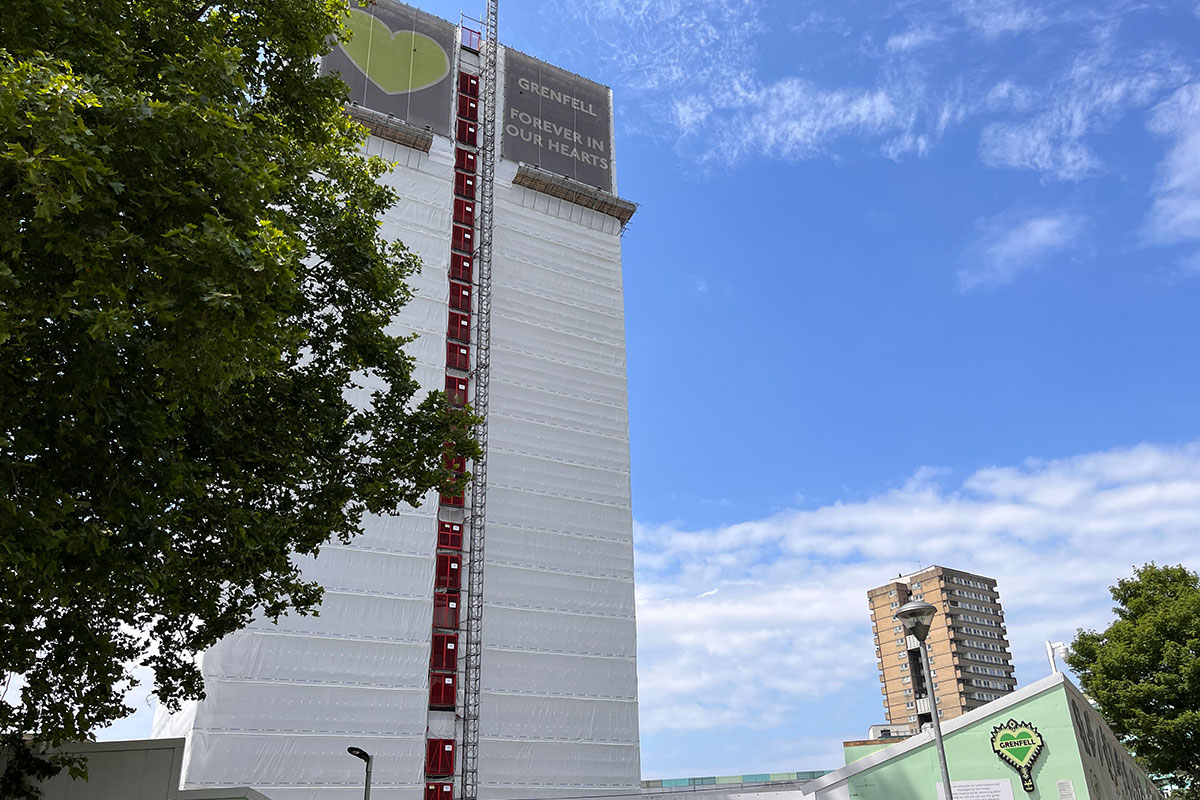You are viewing 1 of your 1 free articles

Professor Ed Galea is director of the Fire Safety Engineering Group at the University of Greenwich
The government’s rejection of evacuation plans for disabled residents arises from false premises based on misinformation
The government based its decision to reject the key Grenfell Tower Inquiry recommendation on the views of those without experience of personal emergency evacuation plans. If the government was serious, it would challenge – not perpetuate – misconceptions, writes Professor Ed Galea
Five years since the Grenfell tragedy, two-and-a-half years since the Grenfell Inquiry phase one report made personal emergency evacuation plans (PEEPs) a key recommendation, and one year since a Home Office public consultation found 83% support for their implementation, the government has proposed abandoning the policy.
The reason appears to be that alongside overwhelming support for PEEPs, the Home Office consultation findings highlighted some concerns. And rather than exploring their legitimacy and how they could be addressed – consistent with evidence-based policymaking – the Home Office took unsubstantiated claims at face value, concluding that PEEPs could not be employed for reasons of “practicality, proportionality and safety”. How is this possible?
From my reading of the consultation document, and its conclusions and recommendations, it appears there are significant misconceptions about what PEEPs are and what they involve.
They are actually a way to identify obstacles that may make it difficult or impossible for disabled residents to evacuate a burning building safely, should the need arise.
And they suggest reasonable mitigations that can be implemented to assist in the evacuation of disabled residents, thereby identifying and reducing life safety risks. It is important to understand that, as with any fire mitigation measure, PEEPs are not intended to reduce life safety risks to zero, but to identify, manage and reduce risks to a reasonable level.
The formal PEEP consultation consisted of two phases: an online questionnaire, open to all interested parties and members of the public, and four workshops, also open to interested parties.
Respondents to the questionnaire were asked their opinion on four government proposals concerning the implementation of PEEPs, and had an opportunity to feed back further views on each of the proposals.
Support for each proposal varied, from 83% to 90%. In the workshops, concerns raised by stakeholders could be challenged and addressed by others.
Even though the government describes the 18 May document as its response to this formal consultation, it reports the findings of the formal consultation process, without its response to the latter, or recommendations based on it.
It appears that instead, a substantive part of the Home Office response is based on a series of private meetings conducted after the formal consultation.
These meetings were held with representatives from 18 organisations representing local authorities and housing associations from throughout England (ie organisation types that represented 40% of the participants in the formal consultation).
“From my reading of the consultation document, and its conclusions and recommendations, it appears there are significant misconceptions about what PEEPs are and what they involve”
These meetings allowed this select group of stakeholders, who appear to have been largely sceptical of PEEPs, to again feed back their opinions, this time without challenge from stakeholders supportive of PEEPs.
While it is reasonable to follow up the consultation process with meetings with ‘experts’, this should not be confused with the results of the formal consultation, and for these ‘expert’ meetings to be of real value, they should be balanced, with views from either side of the argument.
It is simply not credible to seek ‘expert’ information from only one side, present it as part of the formal consultation response, and base the majority of conclusions and recommendations on this private, unsubstantiated opinion.
As it turns out, the representatives from the 18 organisations involved in the private follow-up meetings do not appear to have implemented PEEPs, or anything vaguely like them.
Their replies are not based on practical experience, and do not represent the views of organisations with actual experience of implementing PEEPs.
The views expressed appear to be biased opinion, echoing the fears and scaremongering of some of the organisations that responded to the formal consultation.
It could further be argued that the organisations in these ‘follow-up’ meetings don’t even have a deep understanding of human behaviour and evacuation dynamics.
As such, the Home Office has simply given another platform for certain organisations to express their fears of PEEPs, without pursuing, exploring or even entertaining informed counter-argument, consistent with evidence-based policymaking.
The Home Office appears to have based its response to the formal consultation solely on the views of a number of misinformed organisations, collected outside the stated formal consultation process. It is as if the views of these few organisations trump all other expert opinions.
But its objections to PEEPs were based largely on misconceptions.
While there was overwhelming support for the concept of PEEPs, the consultation process highlighted concerns expressed by some, apparently influential, participants. These concerns are associated with the collection and administration of information associated with PEEPs, the dissemination of that information, and the implementation of suggested PEEP mitigations.
Most of the latter are due to misconceptions, such as the need to have permanent staff, and concerns about the reliability of family, friends and neighbours, an inability to train them, excessive costs etc. While some may be legitimate concerns, many are based on misinformation and false premises, or arise from a lack of critical thinking.
“The Home Office has simply given another platform for certain organisations to express their fears of PEEPs, without pursuing, exploring or even entertaining informed counter-argument”
Central to the concerns of some was the use of volunteers – family, friends and neighbours – to implement the assisted evacuation of disabled residents in general needs housing, rather than permanent full-time paid staff.
These concerns manifested themselves in many ways throughout the formal consultation, and in the ‘follow-up’ private meetings.
The government has endorsed this position, without presenting evidence to support it. Maintaining that PEEPs cannot be implemented safely by volunteers, they ignore that this works perfectly well in office buildings, and that the National Fire Chiefs Council (NFCC), in its draft unpublished update to the Simultaneous Evacuation Guidance document, supports the use of “care providers, family and friends” to implement PEEPs.
The government also chooses to ignore the evidence from the US and Canada, where friends and family can be used as buddies to operate evacuation devices to assist disabled people to evacuate from residential buildings.
By accepting this myth, the cost of implementing PEEPs is artificially inflated to support the specious government argument that PEEPs are not ‘proportionate’.
“While PEEPs are not a guarantee of success, they identify specific risk factors, and implement mitigations that reduce the identified risk to acceptable levels”
It was also claimed that volunteers do not provide a ‘guaranteed’ method of support and so cannot be considered.
It is essential to understand that any fire safety measure, even the sacred concept of compartmentation, upon which the ‘stay put’ philosophy is based, never comes with a guarantee of success.
For example, a study has recently suggested that the frequency of compartmentation failure in fires within ‘stay put’ residential blocks of flats (eg the recent Deptford fire) averaged 10 per month over the 10-year period to 2020 (excluding smoke spread), and this only accounts for failures prior to the arrival of the fire service.
This is why even ‘stay put’ buildings need to have a viable Plan B (evacuation strategy), of which PEEPs form an integral part. Even the ability of the fire service to control the fire and undertake ‘emergency evacuation’ (as suggested by the government’s Emergency Evacuation Information Sharing – or EEIS – proposal) is not guaranteed.
It appears that PEEPs are the only measure the government requires to have an iron-clad guarantee, while all other measures, in reality, are essentially ‘best efforts’. While PEEPs are not a guarantee of success, they identify specific risk factors, and implement mitigations that reduce the identified risk to acceptable levels.
If the Grenfell Tower Inquiry proposals are implemented in full, essentially all high-rise residential buildings will have three layers of safety: Plan A (stay put), Plan B (evacuation, including PEEPs) and Plan C (‘emergency evacuation’ by the fire and rescue service).
And the fire service will have two operational plans: Plan A (extinguish the fire) and Plan B (fire and rescue service-instigated ‘emergency evacuation’).
So if, for any reason, the building Plan B failed to ensure the safe evacuation of all, the building Plan C would be implemented.
This multi-layered approach to building safety is called ‘safety in depth’, something that is lacking in current fire safety planning.
As there is currently no building Plan B (evacuation plan including PEEPs), residents who cannot self-evacuate are wholly reliant on fire service-instigated ‘emergency evacuation’.
While the London Fire Brigade reports that it has developed a robust ‘emergency evacuation’ strategy for high-rise residential buildings, it is unclear how it would propose to safely instigate and manage ‘emergency evacuation’ of all disabled residents, let alone all residents unable to evacuate.
Another recurring claim is that volunteers may not be present on the day or at the time of the emergency and so cannot be relied on.
However, PEEPs, commonly applied in office buildings, are subject to the same limitation, yet they are considered an acceptable mitigation strategy.
In many office buildings, there are likely to be a large number of disabled staff (including those with temporary disabilities) who require a PEEP and assistance to evacuate.
In these buildings, it is unlikely that there would be sufficient specially employed staff to provide the required assistance, so volunteers – often called ‘buddies’ – are typically used to assist disabled colleagues in an emergency.
Buddies are regular employees trained in the general evacuation process and in the specialist skills required to assist their disabled colleague, eg how to use an evacuation chair. As buddies are regular work colleagues, there is no guarantee they will be in the building at the time of the emergency; they could be out to lunch, at an offsite meeting, on vacation or off sick, for example. But this does not mean that PEEPs cannot be implemented in workplaces.
“It appears that PEEPs are the only measure the government requires to have an iron-clad guarantee, while all other measures, in reality, are essentially ‘best efforts’”
Similarly, for residential buildings, there is no guarantee that the ‘buddy’ will be available when required. This risk would be identified in the PEEP documentation and, where possible, measures would be put in place to mitigate it, eg provide more than one buddy.
Furthermore, as this risk would be identified in the disabled person’s PEEP documentation, the fire service would be aware of this possibility and, as part of its Plan B (ie building Plan C), would prioritise the disabled person for ‘emergency evacuation’ if they were not accounted for.
As far as costs are concerned, using family, friends and neighbours as buddies rather than permanent 24/7 staff significantly changes the cost equation. Furthermore, the government and some respondents appear to be fixated on disabled residents with mobility impairments.
Assessing a person’s ability to evacuate starts with whether they have the ability to detect an alarm, correctly interpret it, and correctly decide how to respond. Then assessing their ability to exit the flat, identify where the floor exit is, move across the communal parts of the floor to the exit point, open and pass through the fire door protecting the stairs, move to the head of the stairs, traverse the stairs, exit them through a fire door, and then finally exit the building to an assembly point.
People with disabilities may have difficulty with some or all of these things; a PEEP is intended to identify the problem areas and provide mitigations. For many of these issues, mitigation will not be expensive, eg providing a vibrating pillow alarm for deaf residents, or a guiding arm from a buddy to assist a blind neighbour to descend the stairs.
Finally, the cost of implementing PEEPs should be compared with the costs of doing nothing, or the government’s proposed, costly alternative (EEIS), where the fire and rescue service has the responsibility for the ‘emergency evacuation’ of the entire building.
While stakeholders in the formal consultation provided robust evidence to rebut or address all of these concerns, the government appears to have ignored these responses, preferring to listen to the opinions of those who, by their own admission, have no experience of implementing PEEPs.
The government alternative to the application of PEEPs for disabled residents in all buildings is the five-step EEIS proposition for just ‘at risk’ buildings.
As part of this plan, the fire and rescue service would have responsibility for the emergency evacuation of all residents, including those with disabilities.
“While stakeholders in the formal consultation provided robust evidence to rebut or address all of these concerns, the government appears to have ignored these responses, preferring to listen to the opinions of those who, by their own admission, have no experience of implementing PEEPs”
So rather than providing a potential means for disabled people to be assisted to evacuate a burning building, the government believes it is “proportionate and safe” to leave them, while those who can evacuate attempt to do so. All those remaining would have to wait for possible eventual ‘emergency evacuation’ by the fire and rescue service. And this process is only intended for what are considered ‘at risk’ buildings.
The EEIS would not be required for ‘stay put’ buildings such as the one involved in the recent devastating Deptford fire. Nor would it have been required for Grenfell Tower, a ‘stay put’ building, had this recommendation been implemented prior to 14 June 2017.
While it is a good idea to have emergency evacuation by the fire and rescue service as a backup to the building evacuation plan (including PEEPs), it is unrealistic, and potentially dangerous, for the primary evacuation plan for all residents to rely so heavily on the fire service. The additional staff, equipment and training they would need to deliver this safely would also make the EEIS a potentially costly alternative.
The intended ‘person-centred fire risk assessment (PCFRA)’ and ‘home fire safety visit (HFSV)’ undertaken in step three of the EEIS (instead of a PEEP assessment) would assess fire safety issues within the flat of the disabled person.
Typical potential mitigations to these risks that would be suggested by the PCFRA/HFSV include fire-retardant blankets, flame-retardant bedding and/or fire-safe ashtrays. These are useful fire safety measures in themselves, but not for building evacuation.
How is a fire-safe ashtray going to assist the disabled person when compartmentation has failed, the building is burning, and they cannot evacuate? The PCFRA is like being on a sinking ship and the coast guard throwing you a parachute.
Just take a moment to consider what would have happened at Grenfell on 14 June 2017 if the EEIS had been in place at the time. It was a ‘stay put’ building; the EEIS would not have even applied, so the Home Office’s recommended alternative to PEEPs would have made no difference.
“How is a fire-safe ashtray going to assist the disabled person when compartmentation has failed, the building is burning, and they cannot evacuate? The PCFRA is like being on a sinking ship and the coast guard throwing you a parachute”
Even if the EEIS had been applicable, it is unlikely that the outcome would have been substantially different. What if a general building evacuation plan including PEEPs had been implemented? Which would you want for your family?
Many of the concerns raised by respondents to the government’s PEEP consultation arise from false premises based on misinformation and ill-informed opinion.
Clarifying these issues would address much of the legitimate confusion and fears expressed by some organisations, and the scaremongering by others. If the government was serious about wanting to address the evacuation of disabled residents, it would dispel – not perpetuate – myths associated with PEEPs.
It would provide informed guidance to encourage a culture of best practice, invest in developing a digital infrastructure for the secure collection and dissemination of PEEP information, and work towards establishing an evidence base to address legitimate concerns.
The government’s response to the PEEP consultation does none of these things, leaving me to question how the approach aligns with evidence-based policymaking, a central tenet of good government.
Its suggested way forward, the EEIS proposition, if not so dangerous for disabled residents, non-disabled residents and firefighters, would be laughable.
Furthermore, this Home Office response to the Grenfell Inquiry recommendation that PEEPs be applied to all buildings only applies to ‘at-risk’ buildings. There is therefore no attempt to provide for the needs of the majority of disabled people living in high-rise buildings and no Home Office response to the Grenfell Inquiry recommendation.
While it has not been possible here to address all the issues raised in the PEEP consultation report, I highlight and discuss the key recurring themes in a LinkedIn article here.
Professor Ed Galea, director, Fire Safety Engineering Group, University of Greenwich
Sign up for our fire safety newsletter
Already have an account? Click here to manage your newsletters












